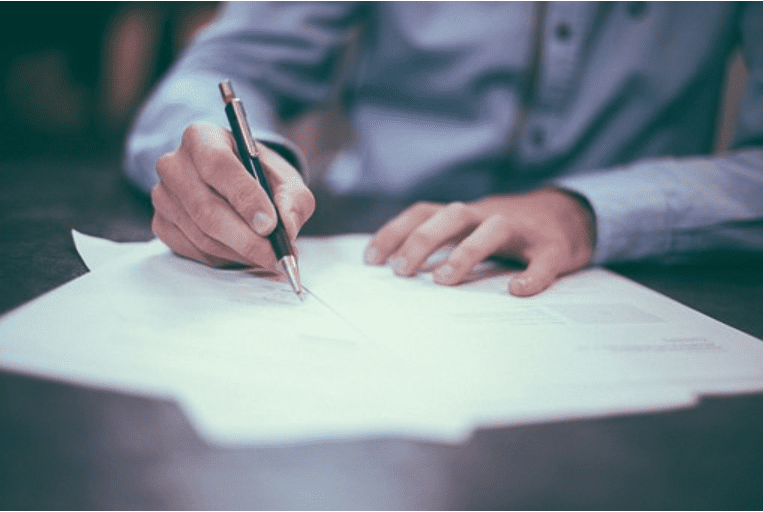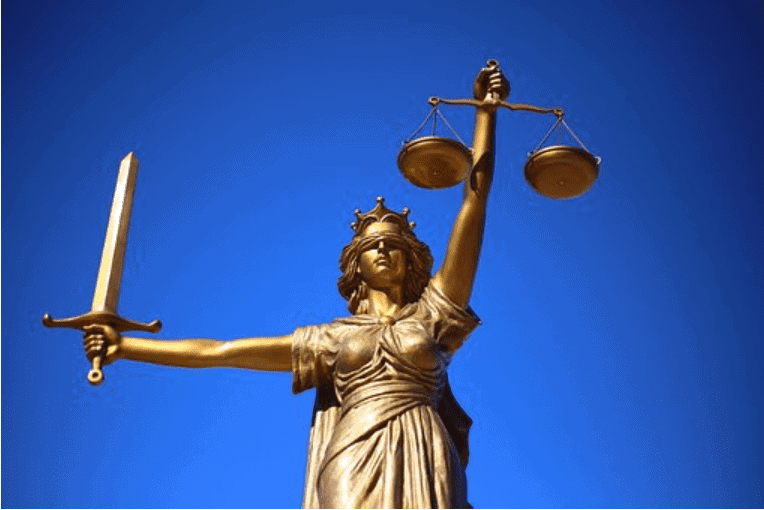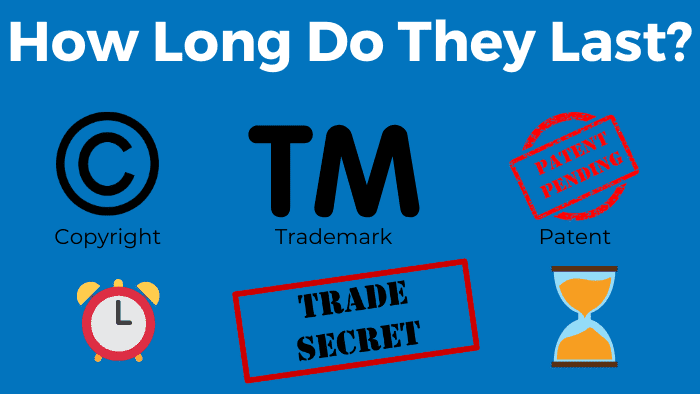For those that want “just the facts, man,” I’m going to deliver those first. Then I’ll dive deeper into each category below for those who might want to know how to take advantage of each type:
- Patents
- Utility & Plant Patents: 20 years from the date of filing
- Design Patents: 15 years from the date of issuance
- Trademarks
- Forever; so long as the mark is not abandoned, or becomes a generic term
- Copyrights
- Life of the Artist + 70 Years
- Trade Secrets
- Forever; so long as the secret remains a secret, and has economic value
- Image/Likeness
- Life of the Individual
Those are the facts! Have more questions? Thought so… So, let’s dive into each of these 5 sub-headings and explore how to maximize rights at the onset and throughout the duration of enforceability.
- Avoid Prosecution Missteps that Impact Duration
- How to Extend Duration beyond Statutory Limit
- Validity Concerns and Duration
- Maintenance and Administrative Issues and Duration
- Enforcing Infringement and Duration
Avoid Prosecution Missteps that Impact Duration
When I say “prosecution”, it is just a fancy word for “acquiring” or “getting” the intellectual property asset (patent, trademark, copyright, trade secret, or status). Sometimes, as we will discuss, the trouble happens (albeit undetected initially) in the getting. Sometimes this is done knowingly, but more often it’s unknowingly by either innovator or the attorney/agent helping them.
So, let’s talk about each area of IP in turn and discuss briefly the key things that need to be thought of upfront that could help you avoid issues down the road in terms of how long your rights will be enforceable:
Patents
Whether it’s a design, plant or utility patent, during the application phase, every word, form, document uploaded, and communication with the United States Patent and Trademark Office (USPTO) counts. Here are some of the major early-stage/prosecution areas that can affect the duration of your patent rights:
- Statutory Bars: If you’ve disclosed, sold, or offered for sale your invention, and it’s been more than one year, your invention could be invalidated upon a successful showing
- Prior Art: No matter how perfect a patent search you or your attorney conducts, there are never any guarantees that all prior art will be found prior to filing, and there’s no guarantee that the examiner will find all relevant art either! This means that when enforcing your rights against an infringer, they could conceivably produce a reference (patent or publication) that predates your filing date, and invalidate your invention…so – do NOT short change your search!
- Estoppel: Based on arguments or amendments made in response to an examiner’s rejection or objection to your invention you may limit the scope of rights you could go after someone once your rights are granted
- Fraud: If either inventor or attorney defrauds the patent office (fails to disclose all necessary facts, fails to identify potential employer-owned rights, etc.) and it was to be found later, it would jeopardize the enforceability of the patent

Trademarks
Whether a logo (design mark) or a wordmark, you simply need to start doing business. By entering business and selling products or services, you are using your name to signify to customers that your name is a source for those particular goods or services.
By virtue of doing business, there is a common-law right created in your use within the geographic scope in which you are doing business. However, if you have plans to expand your client base and/or if you are an online marketplace – where the entire world is your potential client – you ought to seek federal trademark protection.
When making the trademark registration application, if you’re not careful to select which classifications you are currently doing business in, you could miss out on valuable protection for a major area of your business. This is why it is recommended to get a trademark attorney.
Helpful Links:
Blog Article: How Much Does a Trademark Cost?
For example, if you are a hairstylist, and seek registration only for hairdressing services, you will not be able to prevent competitors from using your trademark when selling hair products. It’s key to think big, and think long-term when preparing for a trademark filing.
Copyrights
When recording the art which later becomes the copyrightable subject matter, if there are any co-authors that should be identified, it will be important to list that information during the prosecutorial phase of the copyright process. Something as simple as failing to identify co-authors in a copyright filing could limit the duration if the sole author dies prematurely.
Note that the copyright office is separate from the USPTO. There is actually no examination of the records submitted, but instead, an administrative and automated screening process that verifies the type and quantity of data (author, date, subject matter, specimen, etc.).
How to Extend Duration beyond Statutory Limit
Patents
Inventors get 20 years of protection from the filing date for utility patent applications (15 years for design patents). What few people know is that this is only for the first (also known as the parent) patent. For many inventions, a portfolio of “children patents” is developed as the invention is prosecuted by the examiner.
Divisional patent applications are spawned when an examiner restricts the invention and forces there to be several inventions, or if continuation patent applications are filed with part of the original parent specification being cited. These patent applications often take a life of their own, and if their subject matter and claims are different from the parent, they can have a lifespan that lasts far beyond the 20 years of their respective parent patent.
Trademarks
The rights can theoretically last forever (as long as the business survives), so it’s hard to extend past forever. The key here is to maintain!! We will discuss that later…
There is a risk of having marks become generic and if they do, they will lose their rights associated with them. Examples of brands that have had to fight the popularity and genericization are escalator, band-aid, kleenex, xerox, etc.
Copyrights
These rights extend to the life of the authors/co-authors + 70 years. This period of time cannot be extended through copyright, however, what many famous authors have done is convert the artistic works into a business enterprise, and therefore through development of a BRAND, a trademark is born, which can persist (as you see above) forever (or as long as the company/brand exists).
Examples of this are Disney, while the author of the early cartoons (Walt Disney) would have lost rights to the music and movies themselves, the amazingly strong brand now supersedes those and the artwork is protected by the brand.

Trade Secrets
Much like Trademarks, Trade Secrets can last forever. As long as the secret remains not known by the public, measures are taken to keep the information secret, and it is economically valuable – its a trade secret.
Image/Likeness
The duration is only as long as the individual lives. The duration here is similar to copyrights, in that if the individual is able to develop a brand or business around their image/likeness, then they can extend their ability to protect and monetize it in other ways.
Just think of Michael Jordan’s jump symbol on Nike products, Tiger Wood’s “TW” symbol, or Colonel Sanders’s face on KFC… even if the individual has died (in the case of the late Colonel Sanders), the brand persists.
The important thing to catch here is that these are individual people that have their own likeness/image rights but have extended the duration and scope of protection for their image through trademark rights.
Validity Concerns and Duration
Patents
For patents, once the USPTO has granted the patent rights for a utility, plant, or design patent, the inventor now has the task of enforcing those rights against potential and actual infringers.
A typical inquiry our firm gets is from inventors that hold at least one patent and are looking to assert their rights on an infringer. A classic example is a product that’s being sold on Amazon.com that is a “rip off” of their patented product.
Before we entertain the idea of suing the other party, we explain to the client that there is a process we must go through (see Patent Litigation article for more detail) including verification that the patent claims the client owns are still valid and that there is indeed infringement occurring based on the claim scope.
Validity analysis is true, as it is the case that just because the USPTO approved your invention, doesn’t mean that it will hold up in a court for the entire period of enforcement. Laws can change with respect to what infringement means, what a valid patent is, how much damages you can extract from infringers, etc.
One of the most shocking changes in the law recently was a 2014 decision by the Supreme Court in Alice v. CLS Bank which decided that many software/computer-implemented inventions were no longer valid and enforceable – which drastically impacted those patents’ duration.
Trademarks
A trademark – even after being registered and in place for several years – can be challenged at the Trademark Trial and Appeal Board (TTAB). The procedure is called a “cancellation procedure” and the grounds can be based on prior use or conflict in the same industry/classification.
In other words, someone could attempt to cancel (or invalidate) a trademark because they have evidence that the trademark office missed certain uses in their trademark search, or that there was some sort of foul play/fraud during the trademark application/prosecution phase.
Copyrights
This IP right may be the most resilient against validity attacks after creation. Aside from alleging fraud during the copyright registration process, the arguments are few for attempting to cancel/invalidate a copyright.
As with other areas of IP, lack of enforcement can lead to invalidity and an inability to stop infringers. If the artwork subject to copyright is given away freely online or blatant infringement goes unstopped, courts may see this as an abandonment of rights, or at the very least disallow an infringement action on the basis of laches (which means you sat on your rights).

Trade Secrets
To be valid, a trade secret must be not well known in the public, efforts must be taken to keep the information secret within the company, and it must be economically valuable (usually to competitors in the same niche). If any one of these elements ceases to be the case, the trade secret will lose its enforceability and therefore the duration of the right becomes limited.
For many trade secret processes, systems, methods, algorithms, and techniques, it becomes inevitable that others in the industry will figure them out either through their own innovation or by reverse engineering/trial and error.
However, the ongoing efforts to keep valuable trade secret information within the company are within the control of the company. Therefore rigorous internal processes, nondisclosure/confidentiality agreements, and limited access to files will help to promote the validity and duration of a trade secret.
Maintenance and Administrative Issues and Duration
Patents
After a patent is granted, in order to get the entire 20 years from filing date for a utility or plant patent, you have to pay maintenance fees. The fees, as of the writing of this article approach $10,000 over the course of the first 12 years after issuance.
If the maintenance fees go unpaid, the patent will go abandoned, and the rights will cease, therefore affecting duration substantially.
Payment of maintenance fees is therefore very important, so careful docketing and calendaring is why having a professional team of attorneys will help remind you to make payment to keep your rights in force.

Trademarks
While there are no maintenance fees for trademarks, there is an ongoing duty to update the trademark with any additional classifications you have for your business. Without adding and renewing the trademark (or filing new marks) you will limit the duration and scope of protection for all areas of your business.
For example, do you think Starbucks Coffee only has a trademark on coffee roasting? Just think of the areas that they compete? Food, Music, Restaurant, Retail, Advertising, etc.
Copyrights
Many artists rely on the common law copyright protection that bestows on them the exclusive rights to prevent anyone else from copying their works (or derivative works) without their permission.
The challenge in enforcement is having to lay the groundwork for a judge proving that you are the artist and the date of creation. All of this is assumed defacto true if you have a copyright registration!
Trade Secrets
When someone steals a trade secret, it’s not called infringement, it’s called misappropriation (see below in Enforcing Infringement section). 90%+ of the time, misappropriation occurs when employees leave companies and attempt to take knowledge and secrets from one company to the next (competitor).
The primary way in which companies are successful in making claims against ex-employers is by having a bulletproof set of employment documents, or disclosures that clearly indicate the employee understood the information was secret and signed/agreed to not steal/misappropriate it.
Some states have attempted to whittle away at this by giving employees a lot of power in terms of making it illegal to prevent an employee from working for a direct competitor after terminating employment. This is called a non-compete agreement, and while the concept makes sense (which allows a cooling offer period to assure all trade secret knowledge remains at the former company), the problem is that the ex-employee has no way to make a living during this time. So, some states have limited this cooling-off period to 6 months or 1 year. California doesn’t allow any time.
Image/Likeness
Claims for personal appearance or infringement of one’s privacy (via tort claim) are usually unsuccessful without a showing of damages. A classic example of an image/likeness case is defamation, false light, or libel cases. In all of these tort cases, the problem is that someone or some entity is showcasing a person’s image/likeness in a way that is untrue or damages their reputation somehow.
While it’s sad to say, in order to claim (substantial) damages, the person whose image/likeness was infringed must demonstrate that they HAD a valuable reputation to begin with. In most cases, a person must truly be famous and well known by the public in order to have a claim that merits litigation.
Enforcing Infringement and Duration
Patents
So, you’ve got a patent and you’re ready to launch into litigation against a would-be infringer? Be careful… Most companies that are allegedly infringing will not start with defending themselves, but will instead seek to invalidate your patent at the PTAB first.
In short, your plans to win on the merits in court could be thwarted by a PTAB proceeding. Most federal courts will “stay” (or put on pause) the litigation until a final decision is handed down from the PTAB, who are the expert judges who know patent law very well. Even in federal court, a judge can deem your patent claims invalid, and cut the duration of your patent rights short.
So, even while contemplating litigation, you need to be careful, or else your patent could be invalidated and the duration shortened in a hurry.

Trademarks
Just as in the patent scenario above, when bringing a trademark infringement claim (under the Lanham Act), a defendant can first try to cancel your trademark (invalidate it) at the TTAB first while the federal court stays further litigation until there is a final decision there.
So, the lesson here is to work with experienced trademark counsel to confirm that your trademark is valid and enforceable prior to bringing a claim against a potential infringer.
Copyrights
There is no administrative panel for copyrights, as there is for Patents (PTAB) and Trademarks (TTAB) as mentioned above. However, works of art can be challenged for validity based on defrauding the copyright office or for failing to disclose all co-authors, etc.
Enforcement action for copyrights is solely in federal court, and if there are problems in gathering documents proving the creation of the artwork (timing, who created it, corroborating specimens, etc.) and if there was no copyright registration – this can be a big issue in being able to win the case.
Trade Secrets
A very interesting thing about trade secrets and enforcing them is that there is a risk of disclosure (and therefore immediate loss of the trade secret) if the subject matter of the trade secret gets exposed during the litigation.
While most judges will allow the case to be “under seal” (meaning not publicized), problems can occur when cases are in the public eye, and questions get asked of jurors, witnesses, and even attorneys on the case. Small pieces of the trade secret can spill out, and eventually, the entire thing can become part of the public record – which inevitably will destroy the trade secret.

This happened with a case with magician David Copperfield, where his trade secrets behind one of the magic tricks – which was the center of a negligence dispute with an audience member – became part of the public record.
In Summary
So… there you have it! All of the nitty-gritty details about how long different intellectual property rights will last and what complications could arise.
To re-cap, the important things we discussed include:
- The general lifespans of patents, trademarks, copyrights, and trade secrets
- Avoiding prosecution missteps that impact duration
- Extending the duration beyond the statutory limit
- Validity concerns and duration
- Maintenance and administrative Issues and duration
- Enforcing infringement and duration
It is my hope that this article will inspire you to make the most of your intellectual property rights. How might you extend the protection of your original ideas? Did any of this information inspire you to Go Big and Go Bold℠ ?
Legal Note: This blog article does not constitute as legal advice. Although the article was written by a licensed USPTO patent attorney there are many factors and complexities that come into patenting an idea. We recommend you consult a lawyer if you want legal advice for your particular situation. No attorney-client or confidential relationship exists by simply reading and applying the steps stated in this blog article.

